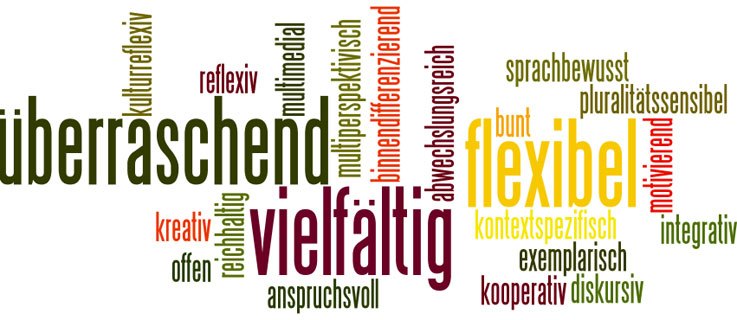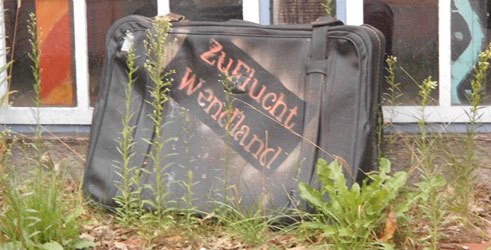The DACH principle in practice
Viewing diversity as an opportunity

Viewing diversity as normality, the DACH principle uses the diversity of the German language and the German-speaking area as an opportunity for multidimensionality in GFL teaching. This article uses quotes from teachers to illustrate the DACH principle and exemplifies how the principle may be advanced discursively.
By Antje Rüger
Servus! Grüezi! Guten Tag! Moin, Moin! Grüß Gott! – Which of these various greetings would you spontaneously choose? “German is not a country but rather a pluricentric language featuring linguistic and standard varieties”, says Australian German teacher Catherine Gosling. Besides dialects and regional colloquial forms, three standard varieties can be distinguished: the High German spoken in Germany (D), Austria (A) and Switzerland (CH). Admittedly, the differences between the varieties are so slight that they do not pose any obstacle to understanding (even among GFL learners) (cf. Shafer 2017). Nonetheless, vocabulary and pronunciation variants do permit interesting language comparisons. “For example, the Dutch word aardappel shows far more similarities with the Austrian word Erdapfel than with the German word Kartoffel”, explains Sabine Jentges, a GFL lecturer in the Netherlands.
As Ibrahim Keita from Mali comments, his German learners find it surprising and therefore motivating to discover that there are several German-speaking countries in Europe, and that things that they use in their everyday lives are produced there: “The learners are so pleased to find that a widely-used product such as bazin – a fabric that is very popular in Mali – comes from Germany or Austria”.
DACHL: Yes, but how?
In the Netherlands, Sabine Jentges takes advantage of Germany’s proximity, embarking on “journeys of discovery: tracking down DACH products in supermarkets, looking for linguistic and cultural clues in the public domain, exploring advertising and its significance or origin […] Such activities can help overcome monolingual and unidimensional mental images of the target language area at linguistic and cultural levels.”One important goal of the DACH principle is to sensitize learners to the diversity of our world and to get them to embrace multiple perspectives as the norm. This principle involves drawing on the linguistic, national and cultural diversity of the DACHL area (Germany, Austria, Switzerland, Lichtenstein and other countries) in GFL teaching. Lessons based on the DACH principle can provide a platform upon which to think about social diversity, raise awareness of different lifestyles and teach students how to deal with diversity.
Role plays and drama allow learners to actively immerse themselves in new perspectives and also experience them on an emotional level, as Lithuanian teacher Agne Blazeviciene reports happened when she staged a production of Franz Hohler’s short story Wie die Berge in die Schweiz kamen (i.e. How the mountains came to Switzerland). The learners engage intensively with the language used in the story, and make their own costumes and props. Unusual and humorous perspectives can be found for instance in literature, short films and videos.
For Michaela Kováčová from Slovakia, the DACH principle allows one to consciously compare the DACHL countries and ask “how the various developments came about. At times this search for causes and their determinants can be rather like exciting detective work and calls for an interdisciplinary approach (linguistics, cultural studies, sociology, cultural anthropology, history).”
The results of the DACHL-Fundstücke competition also offer some creative approaches and ideas for identifying DACHL peculiarities. The proposed didactic concepts aim to give examples which, in a very specific way, “provide food for thought and provoke a discussion, and give unusual insights into the German-speaking countries – above and beyond the usual clichés” (Mohr/Rüger 2016) and encourage learners to critically review their existing attitudes. And of course, all over the world, other DACHL finds are just waiting to be discovered.
 One of the 16 prize-winning DACHL finds
| Photo (detail): © Sandra Spiller
One of the 16 prize-winning DACHL finds
| Photo (detail): © Sandra Spiller
Symposium “The DACH principle in practice”
At a symposium that took place at the Goethe-Institut’s headquarters in Munich on 8 March 2018, more than 50 GFL experts from universities, intermediary organizations and publishing houses discussed how the DACH principle can be implemented in lessons, in the training and continuing education of teachers and in the development of materials. The findings of the symposium can be found on the IDV’s website.
Considering the next stage
The examples and experiences from practice show that there are many possible approaches to teaching GFL according to the DACH-Principle. However, the DACH principle is about more than simply listing the linguistic and cultural phenomena of the German-speaking countries. As regards the linguistic dimension, the focus should be not only on fostering an understanding of different varieties, but also on a dynamic definition of language and on taking pleasure in the diversity of expression. When it comes to dealing with cultural diversity in the GFL classroom, the DACH principle – taken to the next stage – is based on positions in cultural and discourse studies (cf. SIG 2.4). An expert discussion of precisely this point is still in full swing (see Altmayer 2013 and Schweiger/Hägi/Döll 2015).GFL lessons should not primarily teach how something actually is in Austria or Bern or Thuringia, but how people talk, write, discuss and think about it. It is a matter of identifying which discourses, associations and debates are related to the topics and contents that are being dealt with. After all, although they tend not to be called into question and are presumed to be known, terms such as Tirol, Hochdeutsch, Wessi, Heimat or Neutralität do not simply exist but are linguistically created, negotiated and passed on – but not necessarily in the same way in all texts produced in German. In some cases, such terms are also instrumentalized, for example for commercial, touristic or political purposes.
Where and what is the south?
Some apparently unpolitical and universal terms can often be interpreted in various different ways that are not conveyed automatically when the term is translated into other languages. Take the word Süden (i.e. south), for instance. When learners of German in Argentina read the sentence “We are heading south”, what springs to their minds may be not only the geographical and natural scientific phenomenon of the four compass points, but also unspoilt nature, craggy mountains, snow, cold and penguins. On the other hand, a headline like “Fly south directly from Salzburg” or the song Auf der Strasse nach Süden (i.e. On the road south) tend to conjure up images of (overcrowded) beaches, holidays, palm trees, sunshine, summer weather and various notions of Mediterranean or possibly oriental food. In many German-language texts, the south is synonymous with freedom and Italy, a place that even J.W. von Goethe yearned for. By contrast, one would not immediately think of Australia (which is Latin for southern country). The south of Germany is home to the states of Bavaria and Baden-Württemberg, in Switzerland it is the Italian-speaking canton of Ticino and in Austria the state of Carinthia. These are regions that differ in some cases considerably from one another, both in the way they see themselves and in the way they are viewed from outside. Apart from such local viewpoints, the term Süden also comprises one element of the global political discourse on north-south conflicts or the north-south dialogue.And yet this represents only a small sample of the possible interpretations that are collectively constructed and passed on through our common language and media but are by no means shared universally throughout the German-speaking world. Exploring these many complex layers is the point of GFL lessons that are based on a contemporary DACH principle on a firm cultural studies footing.
Joining in the discussion in and about DACHL
These diverse interpretations and evaluations can find their way into the GFL classroom via textbooks, pictures, music, videos and a wide selection of different texts, and indeed also via teachers and other contact persons. As a result, learners can be taught how to look beyond the apparent reality that is created by (the German) language. They learn how to view interpretations as changing constructs and themselves to engage actively, reflectively and critically with such negotiation processes – that is to say to join in and take part. In this sense, the abbreviation DACH can be read as Diversität als Chance (i.e. an opportunity to embrace diversity).Exactly how the DACH principle should best be put into practice will need to be decided on the basis of the specific learning situation, target group and interests, however. So the question is, how will you implement DACH in your German lessons?
Literature
Altmayer, Claus (2013): Die DACH-Landeskunde im Spiegel aktueller kulturwissenschaftlicher Ansätze. In: Demmig, Silvia/Hägi, Sara/Schweiger, Hannes (Ed.) (2013): DACH-Landeskunde. Theorie – Geschichte – Praxis. München: Iudicium, p. 15-31.
Shafer, Naomi (2017): Varietäten und Varianten verstehen lernen: Zum Umgang mit Standardvariation in Deutsch als Fremdsprache. Dissertation, University of Fribourg.
Schweiger, Hannes/Hägi, Sara/Döll, Marion (2015): Landeskundliche und (kultur-)reflexive Konzepte. Impulse für die Praxis. In: Fremdsprache Deutsch. Edition 52, p. 3-10.